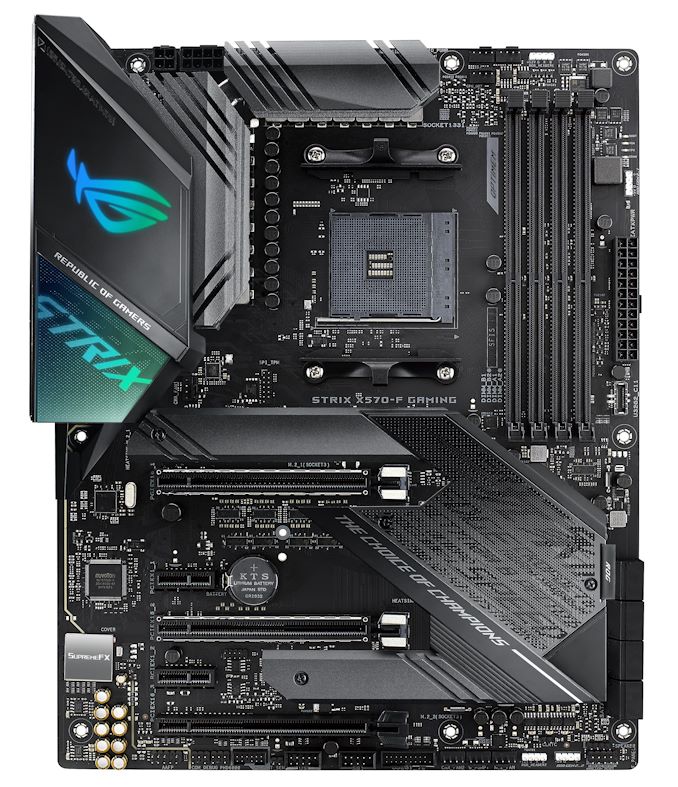The AMD X570 Motherboard Overview: Over 35+ Motherboards Analyzed
by Gavin Bonshor on July 9, 2019 8:00 AM ESTASUS ROG Strix X570-F Gaming
The ASUS ROG Strix X570-F Gaming is the slightly feature slimming ATX sibling of the ROG Strix X570-E Gaming with a very similar aesthetic shared between both models, with fewer premium components and is representative of the mid-range segment of its X570 product stack. The most notable features of the Strix X570-F Gaming include two PCIe 4.0 M.2 slots, eight SATA ports, and an HDMI 2.0b video output on the rear panel. On the design, ASUS has gone with a gaming-inspired which theme of black and grey, with ARGB LEDs implemented into the rear panel cover for a bit of extra flair. The actively cooled X570 chipset heatsink also includes a graffiti-inspired design which fits in with the rest of the board's theme.
On the PCB of the ASUS ROG Strix X570-F Gaming is three full-length PCIe 4.0 ports which are configured to run at x16, x8/x8, and x8/x8/x4. This allows users to run up to two-way NVIDIA SLI and three-way AMD CrossFire multi-graphics card setups. Storage capabilities onboard include two PCIe 4.0 M.2 slots with a pair of M.2 heatsinks which the PCIe 4.0 x4 SSDs are certainly going to appreciate. The board also includes eight SATA ports with support for RAID 0, 1, and 10 arrays. The ASUS ROG Strix X570-F also has four memory slots with the capabilities to run up to 128 GB. Memory support isn't known at present, but more information should be available when this model launches, sometime after 7/7.
The ASUS ROG Strix X570-F uses a single Ethernet port controlled by an Intel I1211-AT Gigabit NIC, while the five 3.5 mm audio jacks and S/PDIF optical output are driven by a SupremeFX S1220 HD audio codec. Looking at rear panel USB, there's three USB 3.1 G2Type-A, one USB 3.1 G2 Type-C, and four USB 3.1 G1 Type-A ports. Also present on the rear panel is a pair of video outputs consisting of a DisplayPort and HDMI 2.0b, with a USB BIOS Flashback button that uses a dedicated USB Type-A port which is clearly highlighted on the IO shield.
Similar to the ASUS ROG X570-E Gaming in terms of stylings, the ROG X570-F Gaming drops some key features to offer users looking for the Strix style, but without the larger hit to the wallet. While a few of ASUS's X570 models are doubled up with Wi-Fi enabled and those without, the Strix-X570-F keeps the core layout, but without the cost-laden features such as Wi-Fi 6, and a 2.5 G NIC. The ASUS ROG Strix X570-F Gaming is almost certainly going to cost less than its better equipped X570-E Gaming sibling, but we currently don't have an MSRP at the time of writing, and this model won't be available at launch.












225 Comments
View All Comments
Supercell99 - Tuesday, July 9, 2019 - link
I also expected benchmarks and a naked woman serving me a beer.haukionkannel - Wednesday, July 10, 2019 - link
You did not get that? That is really strange... I was sure that that was the basic service in here!;)
Gastec - Wednesday, July 10, 2019 - link
I had a dream last night about a woman, she was serving me...benchmarks :)Duncan Macdonald - Tuesday, July 9, 2019 - link
Why is the DDR4 memory speed being shown as a feature of the chipset? The memory is directly driven by the CPU not the chipset and as such the memory speed is independent of the chipset.Dug - Tuesday, July 9, 2019 - link
The motherboard still has work to do and is what supports the faster speed memory. Just because the cpu allows it, doesn't mean it will work without the correct chipset.thomasg - Tuesday, July 9, 2019 - link
The chipset has nothing to do with it, it has no relation to RAM clock and is exclusively driven by the PCIe clock, which is unrelated.The mainboard itself has the traces and therefore the manufacturer is expected to provide appropriate timing sequences to load into the CPU, which again, is not done on the chipset.
There's no reason a mainboard manufacturer couldn't support faster RAM on any older, compatible board (provided they do a firmware update and the board is designed well enough), a chipset upgrade is not required.
Death666Angel - Wednesday, July 10, 2019 - link
"the board is designed well enough" There is the catch. It might be that Ryzen being the first of its kind meant that many 3xx boards were designed poorly.First test I've seen is TPUs R9 3900x on a ASUS Prime B350 Plus which they claim ran at 3200CL14, but only after setting it to 2666MHz first and letting it train the memory. But it's an encouraging result.
Dug - Tuesday, July 9, 2019 - link
I'm interested in seeing what coolers will fit on the mITX boards. Specifically ASRock X570 Phantom Gaming-ITX TB3.It looks like some of these boards might be limited due to high heatsinks and fans on the motherboards.
Mikewind Dale - Tuesday, July 9, 2019 - link
Could we please have a comparison table? 35 pages is too many read. It would be useful to have a comparison table so that I can narrow down the several motherboards I am interested in, and then compare their prices.halcyon - Tuesday, July 9, 2019 - link
A summary table of features would indeed be very helpful. Way too many boards and pages...